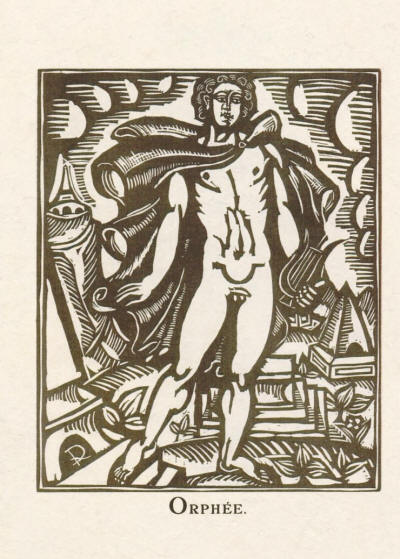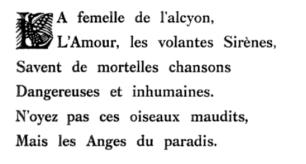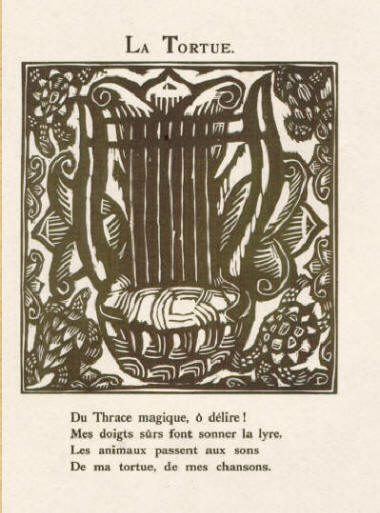| to main page about le Bestiaire | ||||||||||||||||||||||||||||||||||||||||||||||||||||||||||||||||||||||||||||||||||||||||||||||||||||||||||||||||||||||||||||||||||||||||||||||||
Orphée / Orpheus / Apollinaire
|
||||||||||||||||||||||||||||||||||||||||||||||||||||||||||||||||||||||||||||||||||||||||||||||||||||||||||||||||||||||||||||||||||||||||||||||||
|
|
|
|
|
The Bestiaire ou Cortège d'Orphée (Bestiary, or Orpheus' Parade) contains - next to 26 animal emblemata - four woodcuts of Orpheus. Typographically they are set apart: they are the only ones that get a page of their own, the poem printed on the facing page. In these poems Apollinaire confesses his 'orphic' view on the transformative potential of Art. The first poem - a statement: in principio erat - refers to Hermes Trismegistus (the father of Hermetism). Apollinaire highlights his faith in the power of the 'voice' (the word sung, the song): chanson, chant, cantare, incantare. The choice of the first emblema is also telling (I added it as the fifth on this page): the tortoise, but not as an animal, but as the provider of the magic Lyre, the Orpharion. For those who are not versed in Greek mythology and hermetic philosophy, Apollinaire is so kind as to provide the explanation himself in a number of 'scholarly' footnotes, also printed below The English translations on this page: X.J. Kennedy (see his book) |
In Apollinaire's le Bestiaire, ou Cortège d'Orphée staat Orpheus centraal, de mythische dichter die de natuur met zijn zang aan zich onderwerpt (vandaar de subtitel; le cortège d'Orphée: de processie, de stoet van Orpheus). Apollinaire was gefascineerd door de wereld van de mythen, de sagen. Niet antiquarisch, maar als beeld-taal materiaal dat nog steeds de potentie heeft om de conditon humaine te beschrijven èn het belang van de kunst (als transformerende kracht). In le Bestiaire komen vier gedichten voor waarin geen dier, maar Orpheus zelf het onderwerp is. Het eerste gedicht uit Le Bestiaire: Orpheus in volle Griekse glorie - mythisch dus) verwijst al naar de Orfische mystiek (Hermetisme), waarin de stem (m.n. de zang, het lied dus) even elementair is als het licht. Het daaropvolgend gedicht, het eerste embleem (hier opgenomen als vijfde) bezingt het wonderwerkende instrument: het Orpharion (de schildpadlier). Samen zijn ze te lezen als een programma. Voor degenen die het niet meteen doorhebben is Apollinaire zo vriendelijk om het in een paar prachtige voetnoten uit te leggen. U kunt die voetnoten samen met het gedicht/embleem over de schldpad onderaan deze pagina lezen (klik hier). |
|
|
|
|
|
|
|
|
|
|
Admirez le pouvoir insigne |
Bewonder de opmerkelijke
kracht
Admire his inborn might, For Apollinaire's note: see below
|
|
|
|
||
|
|
|
|
|
Regardez cette troupe infecte |
Bezie deze walgelijke
meute
Behold this vile, infesting
mob
|
|
|
note d'Apollinaire:
|
Met betrekking tot dit paleis, een getuigenis van de liefde die de koning van Engeland voor zijn minnares had, dit couplet van een 'complainte' waarvan ik de Auteur niet ken :
About this palace, built as a testimony to the king of England’s love for his mistress, here is a stanza from a mournful old song, author unknown to me:
Opmerking: de Engelse koning en de maitresse van dienst zijn Henry II & Rosamund Clifford, ook elders bij Apollinaire,:
meer legende dan feiten
(12e eeuw), maar dit geheel terzijde |
|
|
|
|
|
|
Que ton coeur soit l’appât et
le ciel, la piscine ! |
Dat uw hart het aas zij en
de hemel, het bassin !
May your heart be the bait
and the heavens your pool!
|
|
|
|
|
|
|
La femelle de l’alcyon, |
Het vrouwtje van de ijsvogel, De Liefde, de vliegende Zeemeerminnen, kennen dodelijke liederen gevaarlijk en onmenselijk. Hoort niet naar deze vervloekte vogels, maar naar de Engelen van het paradijs
The fabulous kingfisher
queen,
|
|
|
Note d'Apollinaire:
|
Het vrouwtje van
de ijsvogel|Halcyon
The female
kingfisher|Halcyon|, |
|
| Emblema 1: La Tortue | ||
|
|
|
|
|
|
||
|
Admirez le
pouvoir insigne Et la noblesse de la ligne. Il loue la ligne qui a formé les images, magnifiques ornements de ce divertissement poétique.
|
Bewonder de opmerkelijke
kracht Hij looft de lijn, die de beelden vormgeeft, prachtige ornamenten bij dit poëtisch tijdverdrijf.
|
Admire his inborn might, His form of noble grandeur! This passage praises the strong line visible in these images, splendid decorations of this poetic entertainment. |
|
Elle est la
voix que la lumière fit entendre Et dont parle Hermès Trismégiste en son Pimandre. " Bientôt, lit-on dans le Pimandre, descendirent des ténèbres ... et il en sortit un cri inarticulé qui semblait de la lumière." Cette voix de la lumière, n'est-ce pas le dessin, c'est-à-dire la ligne. Et quand la lumière s'exprime pleinement tout se colore. La peinture est proprement un langage lumineux.
|
Het is de stem die het licht
laat horen "Spoedig daalde het duister neer... en daaruit steeg een ongearticuleerde schreeuw op die de stem van het licht leek." Is deze stem van het licht niet de tekening, dat wil zeggen de lijn ? En wanneer het licht zich volledig uitdrukt krijgt alles kleur. Schilderkunst is een lichtende taal.
|
Here is the voice heard at the
birth of light, As Trismegistus says in his Pimander. 'Soon,' one reads in the Pimander, 'shadows fell... and out of them came an inarticulate cry that seemed the very voice of light.' Is not this voice of light the craft of drawing, that is to say, the line? And when light fully expresses itself, all things take on color. Properly speaking, painting is luminous language. |
|
Du Thrace magique Orphée était natif de la Thrace. Ce sublime poète jouait d’une lyre que Mercure lui avait donnée. Elle était composée d’une carapace de tortue, de cuir collé à l’entour, de deux branches, d’un chevalet et de cordes faites avec des boyaux de brebis. Mercure donna également de ces lyres à Apollon et à Amphion. Quand Orphée jouait en chantant, les animaux sauvages eux-mêmes venaient écouter son cantique. Orphée inventa toutes les sciences, tous les arts. Fondé dans la magie, il connut l'avenir et prédit chrétiennement l'avènement du SAUVEUR. |
Uit het
magische Thracië |
. . . from magical Thrace!
|
|
|
||













